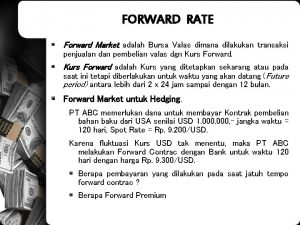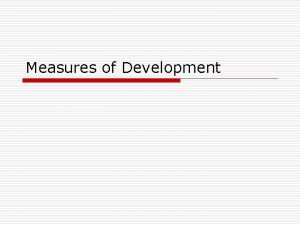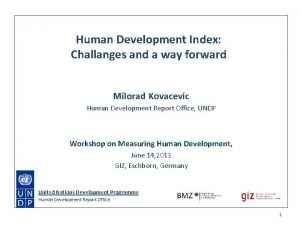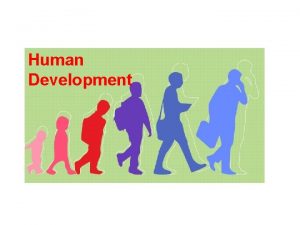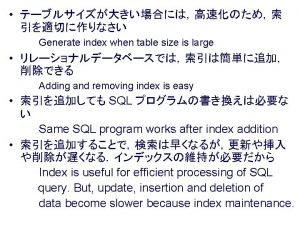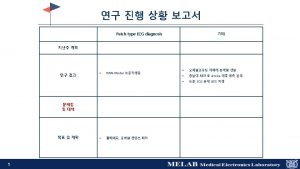Human Development Index Challanges and a way forward

![Human Development A standard definition of human development (1990 HDR): “[…] a process of Human Development A standard definition of human development (1990 HDR): “[…] a process of](https://slidetodoc.com/presentation_image/06a723ffb5b6d4c53f8efb81735f55c7/image-2.jpg)


















- Slides: 20

Human Development Index: Challanges and a way forward Milorad Kovacevic Human Development Report Office, UNDP Workshop on Measuring Human Development, June 14, 2013 GIZ, Eschborn, Germany United Nations Development Programme Human Development Report Office 1
![Human Development A standard definition of human development 1990 HDR a process of Human Development A standard definition of human development (1990 HDR): “[…] a process of](https://slidetodoc.com/presentation_image/06a723ffb5b6d4c53f8efb81735f55c7/image-2.jpg)
Human Development A standard definition of human development (1990 HDR): “[…] a process of enlarging people’s choices to lives they have reason to value… The most critical ones are to lead a long and healthy life, to be knowledgeable and to enjoy a decent standard of living. ” A broader definition (2010 HDR): “Human development is the expansion of people’s freedoms to live long, healthy and creative lives; to advance other goals they have reason to value; and to engage actively in shaping development equitably and sustainably on a shared planet” 2

• • • Measuring is as more relevant than ever Quantifying and describing our changing world Finding ways of improving people’s well-being: o • • • Informed policy making and advocacy Human development is an evolving idea As the world changes – analytical tools change But there is a persistent importance of the chain: Concepts Measurements Impacts 3

Human Development Index Emphasizes that outcomes for people and their capabilities should be the ultimate criteria for assessing the progress of a country, not economic growth alone. Accounts for average achievements in • life expectancy (proxy for leading a long and healthy life), • education (proxy for being knowledgeable) and • income per capita (proxy for command over resources to have a decent standard of living). 4

Human Development Index (Contd. ) A simple index (non-comprehensive) with the purpose of - initiating discussions - attracting attention to issues that prevent countries from performing at a higher level - international comparison and benchmarking - temporal comparison 5

General criteria for a good HDI (Foster, 2013) (I) Corresponds to strong policy and advocacy needs • Understandable and easy to describe - Understandable at a deeper level including goalposts and group-cutoffs Measuring absolute “size of HD” - independent from other countries • Conforms to a notion of what is being measured - Anchored in underlying variables Numbers mean something (II) Concerns the intended purpose of the index • It must fit the purpose for which it is being developed - - Complements GDP or/and GNI Compares HD achievements across countries Monitors progress across time for a given country Analytical utility (subgroups or dimensions) 6

General criteria for a good HDI (contd. ) (III) Theoretically justified • Technically solid - Axioms to make sure that index’s properties conforms to purpose Theoretical framework (within human capabilities approach and/or welfare economics) (IV) Practicality • Operationally viable and easily replicable - Works with existing data for all the countries and all the years - It can be updated in time 7

8

9

How to decide about demarcation cut-offs for categorizing countries into different levels of HD? • Fix absolute demarcation cut-offs for categorizing countries - Choose relatively, then fix absolutely, or - Look within variables for natural cut-offs • Cut-offs are always arbitrary - Like poverty lines, like middle class ranges • But if fixed over time, countries can progress - Consistent cut-offs can be maintained over time 10

Changes in the HDI introduced in 2010 Goal posts Minima: Fixed at “natural zeros” Maxima: Observed maxima since 1980 Comments: • A possible change of maxima every year; • HDI level of Congo depends on LE of Japan, education in USA and GNI of Qatar (!? ) Group cut-offs (relative) Cut-offs: Quartiles of HDI distribution Groups: Quartile groups of equal size Comments: • Little movement mostly within the group • To move to the higher quartile, another country has to move to the lower • Progress against other countries, rather than against arbitrary numerical cut-offs • Fuzzy incentives, less practical value for the country HDI value and rank: change between two years Due to: • Real change in performance • Data revision • Change in goalposts (maxima) 11

Logarithmic transformation of income • Diminishing marginal utility of income 12

Logarithmic transformation in other dimensions • There arguments for and against transforming the health and education variables to account for diminishing returns. • Health and education are not only of intrinsic value; they, like income, are instrumental to other dimensions of human development not included in the HDI. • Their ability to be converted into other ends may likewise incur diminishing returns. HDRO 13

Alternative transformations for variables? • Simplicity is always better • By transforming variables it is harder to interpret change on the ground with change in the index – it is a function of the normalized transformed variables! • No possibility for subgroup decomposition • Chakravarty (2003) with all variables transformed by a common concave function 14

15

Aggregation: Geometric mean Critiques: • A well rounded performance across dimensions is not a requirement within the human development approach • Development/government policies should not be focused on maximizing the HDI • Changing of aspiration levels should be done infrequently and if it is done proportionally (a slope-invariant linear transformation), maxima do not impact ranking by the arithmetic mean based HDI • High discrimination power is based on the accounted inequality across dimensions which is not as important as the inequality within dimension and across population • No decomposition by dimension nor by subpopulation 16

17

• Changing the functional form may cause big changes in the HDI values and ranks especially in the lower end of distribution. Example: LE EDU GNI Stdev HDI (geometric) HDI (arithmetic) Mali . 496 . 270 . 346 . 115 . 359 (175) . 371 (176) Liberia . 580 . 439 . 140 . 225 . 329 (182) . 386 (175) 18

Summary of recommendations 1 • • • Revert to the original arithmetic formula With fixed minima (zeroes) With aspirational cut-offs constrained and updated infrequently With log of income component With fixed cut-offs between groups _____ 1 2 nd Conference on measuring human progress, March 4 -5, New York 19

Thanks Milorad. kovacevic@undp. org 20
 Limitations of pqli
Limitations of pqli Gni definition ap human geography
Gni definition ap human geography Forward market adalah
Forward market adalah Forward market adalah
Forward market adalah Human development index rwanda
Human development index rwanda Indikator sejahtera
Indikator sejahtera Human development index 2018
Human development index 2018 Human development meaning
Human development meaning What is human development
What is human development Cna chapter 8 human needs and human development
Cna chapter 8 human needs and human development Chapter 8 human needs and human development
Chapter 8 human needs and human development Goal reality options way forward
Goal reality options way forward Way forward presentation
Way forward presentation Diff between step index and graded index fiber
Diff between step index and graded index fiber Bacteriological index formula
Bacteriological index formula Single mode fiber supports meridional rays
Single mode fiber supports meridional rays Consistency limit test
Consistency limit test Marginal frequency
Marginal frequency Explain about threaded binary tree
Explain about threaded binary tree Perbedaan one way anova dan two way anova
Perbedaan one way anova dan two way anova The old way and the new way
The old way and the new way



